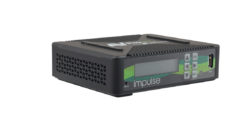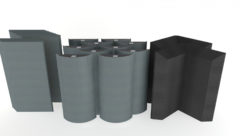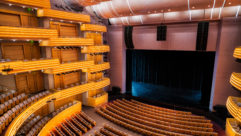Audio among the clouds
Nov 1, 1998 12:00 PM,
Gregory A. DeTogne
A destination resort situated in New Jersey’s Kittatinny Mountains,Mountain Creek takes pride in offering something for everyone. Developed byIntrawest, Vancouver, B.C., Canada, the property draws crowds withmultiseasonal attractions ranging from the sprawling wave pool in its waterpark to 1,040 vertical feet (317 m) of downhill skiing.
One of nine mountain resorts in North America operated by Intrawest,Mountain Creek was formerly known as the Vernon Valley/Great Gorge Ski Areaand Action Park. When the property was acquired by Intrawest in February1998, Mountain Creek president Robin Smith wasted little time in announcingthat visitors could start expecting some changes. With $5 million earmarkedfor 1998 summer season improvements alone, Smith also revealed that planswere underway to spend $25 million more to create a haven for New Yorkmetro area ski and snowboard enthusiasts.
“Our goal is to create a family-oriented park in tune with the naturalsetting of our mountainside location,” he exclaimed. “Tothat end, we’veadded several new attractions and revamped, reworked and reorganized everyexisting attraction on the mountain.”
Mountain Creek kicked off its summer season on June 15, 1998, with theopening of one of the largest water parks in North America. The park houses24 slides and pools, including a cliff jump, a 75 foot (23 m) speed slide,and Cannonball Falls, a completely enclosed body flume. This winter, planscall for unveiling a snowboard park, 26 miles (42 km) of new snowmakingpipe, 714 new snowmaking hydrants and a series of state-of-the-art lifts,including an eight-passenger gondola.
Not overlooked in Mountain Creek’s revitalizing scheme thus far are themusic systems serving the only main lodge area currently in use at the park(a complete renovation of the resort’s old South Lodge is underway, but notyet complete). As with the rest of the property’s attractions, mindfulattention has been given to ensuring that these systems maintain levels offlexibility capable of catering to the widely varied tastes of guests,young and old.
Following an analysis of the environment, Intrawest management decided tostart afresh. To that end, they conferred with Tony Pecoraro, theirelectrical contractor. Pecoraro, whose firm, Pecoraro Electric, is based atthe foot of the mountain in the village of Vernon, made a call to nearbyTotowa, NJ, and enlisted the aid of local systems designer Dave Simonetti.Owner of Sim-O-Rama Sound, Simonetti accepted the challenge and met withboth Pecoraro and an Intrawest representative to discuss Mountain Creek’sneeds.
As described to Simonetti, the resort wanted to install five turnkey audiosystems, all of which would be dedicated to providing reinforcement formusical program material. Located at the southern end of the main lodge,the first system would serve a large, hexagonal multipurpose environment.Equally cavernous in capacity, the Vernon Cafeteria brought Simonetti faceto face with a completely different set of design and performance dilemmas.Of the remaining three systems, two were scheduled to serve food serviceand bar areas. The last was to be a mobile platform for DJ activities.
Simonetti committed himself to a plan that came together under a demandingtimeframe. First hearing of the project in late April, he completed hisspecifications less than two weeks later to ensure that Pecoraro Electriccould finish each system’s construction by the water park’s opening.
The biggest challenge involved the need for flexibility. In the reverberantmultipurpose room (appropriately called “the hex area”), he had to create asystem that could manage the needs of both live performances and recordedprogram material in a fashion that allowed even inexperienced system usersto switch from one application to another quickly.
Similarly demanding in form and function, the Vernon Cafeteria is more thana place where patrons line up with trays, pay for their food, then searchout a table amidst the drone of an unintelligible 70 V distributed system.Among the more arduous sound system tasks required of the space are theyouthful gatherings where high SPLs and dancing are the norm. Therefore,this system needed the power to work 12-hour shifts, providinghigh-fidelity background music and then function well into the night.
For the smaller satellite systems in the food service and bar areas, soundhad to meet the same quality standards as imposed on the larger spaceswhile remaining focused so as not to spill into surrounding areas. On afinal note, the DJ system had to be both mobile and capable of easyinterfacing with any of the other systems.
A bar resides at the core of the hex area enclosed by the room’s openspace, vaulted ceiling, and six sides of reflective glass surfaces, each ofwhich measure 60 feet (18.3 m) in length. In taming the environment’sreverberation times, Simonetti relied upon eight full-range WS-AT300loudspeakers from Panasonic Pro Audio/RAMSA supplemented at the low-end byeight more WS-AT350 subwoofers. Distributed along platforms around the edgeof the room side by side, the loudspeaker arrays focus directly onto thelistening area. Representing one of the first appearances of thesecomponents in the United States, the arrival of the WS-AT300s and WS-AT350sproved to be a case of perfect timing.
“I was looking for a two-way, 15 inch (381 mm) bass reflex loudspeakersystem to complete the design for the hex area,” Simonetti recalled. “Witha 60 degrees x 40 degrees pattern that would bring focus to the room’senergy without aggravating the reverberant field, the RAMSA devices showedup on cue, providing an instant, dependable solution.”
With a frequency response of 70 Hz to 18 kHz, a full-range WS-AT300 cabinetdirects signals to a 15 inch (381 mm), low-frequency transducer and thencrosses over at 2.2 kHz into a constant-directivity horn coupled with aproprietary compression driver employing what RAMSA refers to as SquareContour Wave Guide (SCWG) technology. Unlike traditional rectangular horns,which radiate sound in a diamond-shaped pattern, RAMSA’s horn radiates in acircular pattern, thereby reducing phase cancellation while offeringdirectivity control at angles of 45 degrees horizontally, vertically andobliquely. Capable of handling 400 W continuous program, the WS-AT300’strapezoidal enclosure is made from molded resin.
The WS-AT350 subwoofer employs a 15 inch (381 mm) bass reflex design thatextends low-end response to 30 Hz. Once again imparting a tight, 60 degreesx 40 degrees footprint upon its listening environment, the bass binreceives direction from RAMSA’s dedicated WS-SP2A subwoofer processor.Equipped with a limiter that prevents the full-range WS-AT300 fromover-extending itself on bass passages, the processor channelslow-frequency energy from each of the system’s stereo channels into a monosumming circuit to bring low-frequency boost into the equation at 80 Hz.
Once the loudspeaker arrays were selected for the hex array, the designmade serious headway in meeting the performance needs of the room’s liveand recorded program sources. Simonetti fueled the system with six RAMSAWP-1400 amps that produce 400 W/channel into 4 V.
Next came the unresolved system flexibility issues. As Simonetti viewed thesituation, the system could meet its multipurpose demands most easily andcost effectively via the control end, where a 12-channel RAMSA WR-S4412Aconsole was put to work as the main house board. Featuring four groups withleft and right masters, four aux channels and four returns, the WR-S4412Arelinquishes control of the system to a Rane MP-22 unit when live acts arebrought in.
In keeping with the minimalist, user-friendly mindset of his design, thehex area input list consists of a head-worn wireless mic fromAudio-Technica, a hand-held, hardwired MB-3000 mic also fromAudio-Technica, and a top-loading CDX-12 dual-CD player from Vestax (as ofthis writing, input devices are imported as needed for each live act’sappearance). With power arriving via a Furman PM-8 panel, all systemelectronics are neatly housed in a single 20 RU rack.
Two of the small systems Simonetti created for Mountain Creek-thosepreviously mentioned in a food service area serving pizza and another heardby patrons of the Cowboy Bar-meet the resort’s versatility criteria byaccepting feeds from either the hex area system, a satellite-based musicservice that can be routed to all areas, the portable DJ system or, in thecase of the Cowboy Bar, from its own input sources as mixed by a WR-M10Aconsole.
Sound reinforcement for those ordering pizza comes from four overhead RAMSAWS-A35 near-field loudspeakers held in place with WS-AQ4W mountingbrackets. Power comes from a RAMSA WP-1200 amp producing 200 W/channel into4 V.
Back in the Cowboy Bar, the atmosphere is amply excited thanks to anotherpair of trapezoidal, full-range WS-AT300 enclosures fortified at the bottomend by matching WS-AT350 subwoofers. RAMSA WP-1200 power amps complete thesystem.
One of the regulars in the bar is the Simonetti-designed portable DJsystem. The system moves about in a two-piece cabinet that is slanted atthe top and houses components, including an MX750 mixer from MTX. OfferingDJs an efficient front end that can be interfaced in any of the MountainCreek venues, the DJ rolling stock can stand on its own rackspace thanks tofour compact RAMSA WS-A200 two-way enclosures and a pair of WP-1200 poweramps. A Denon DN-2000 MK III dual CD player joins the parade.
Completing Simonetti’s Mountain Creek efforts is the system designed forthe Vernon Cafeteria. Adding two more sides to the hex area’s six increating a sizable, octagonal area of coverage, the cafeteria is ringed by10 RAMSA WS-A35s. Capable of posting a flat, wide-band frequency responserunning from 80 Hz to 20 kHz, the two-way bass reflex units house 6 inch(152 mm) woofers and RAMSA’s WG 90 degrees constant-directivity sphericalhorns. Peaking at 140 W continuous program, the devices bringdirect-coupled background music to the cafeteria’s seating areas.
For the previously mentioned heavy-duty, high-SPL youthful gatherings thatregularly spill into the cafeteria, another dual WS-AT300/WS-AT350combination is used. Selectable upon demand as a supplement to the WS-A35sabove, this separate system draws power from three WP-1200s and twoWP-1400s. Mixing falls upon the shoulders of another WR-M10A.
Following in Dave Simonetti’s design footsteps, Pecoraro Electric completedthe construction of all five Mountain Creek systems in two days. Afteranother two days of tuning, the keys were handed over to a pleased client.
Today, Mountain Creek continues with plans for further improvement. Thereopening of the still-under-construction south lodge will reveal yetanother Simonetti creation. If there is any lesson here for systemintegrators, it is that with the proliferation of all-season mountainresorts of this nature, new market opportunities will open. Audio goes wellwith water sports after all, and it is viewed by snow-boarding enthusiastsas a vital part of their sport.










